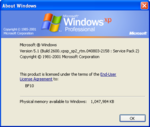Windows XP build 2600.2180
| Build of Windows XP | |
 | |
| OS family | Windows NT |
|---|---|
| Version number | 5.1 |
| Build number | 2600 |
| Build revision | 2180 |
| Architecture | x86 |
| Build lab | xpsp_sp2_rtm |
| Compiled on | 2004-08-03 |
| SKUs | |
| Home Edition (N) Professional (N) Media Center Edition Tablet PC Edition Embedded | |
| About dialog | |
Windows XP build 2600.2180 is the official RTM build of Windows XP Service Pack 2 which was released on 25 August 2004. The Professional Reduced Media Edition SKU of this build was uploaded to the Internet Archive on 25 October 2021 in both English and German languages.[1]
This release would be used as the base for Windows XP Starter Edition, Windows XP Tablet PC Edition 2005, Windows XP Media Center Edition 2005, Windows Fundamentals for Legacy PCs, and Windows Embedded for POS. It was also pushed out to Windows XP Embedded.
Changes from Windows XP SP1[edit | edit source]
- The Security Center has been added, which enhances the Windows Firewall.
- The OOBE has a new page for Automatic Updates.
- The boot screens of all editions have been unified. Most notably, it no longer displays the SKU, and the boot screen for the Home Edition now uses a blue progress bar.
- Native Bluetooth support has been added.
- Improvements to wireless networking.
- The Remote Desktop Connection has been updated to version 5.1.2600.1154.
- Windows Media Player has been updated to version 9.
- .NET Framework has been updated to version 1.1 SP1.
- If a bugcheck appears, the system now reboots automatically after the physical memory has been dumped, if set so. This can be disabled permanently in "Advanced" > "Startup and Recovery" in the System Properties, and temporarily when the dedicated option is selected in the "Advanced Startup Options" during boot.
- Device Manager console got ability to display vendor and device IDs in "Details" tab of devices properties.
- Internet Explorer 6 was updated to SV1 version (a.k.a. IE 6 SP2) with script and pop-up window blocker.
- If the processor supports PAE, an additional line "Physical Address Extension" is added beneath the processor specifications in System Properties.



